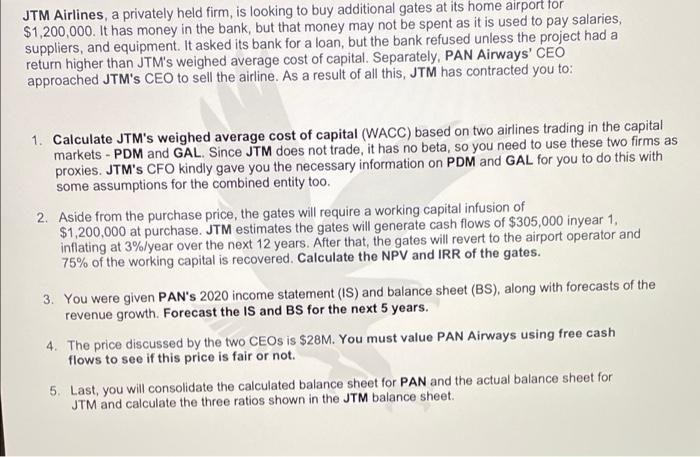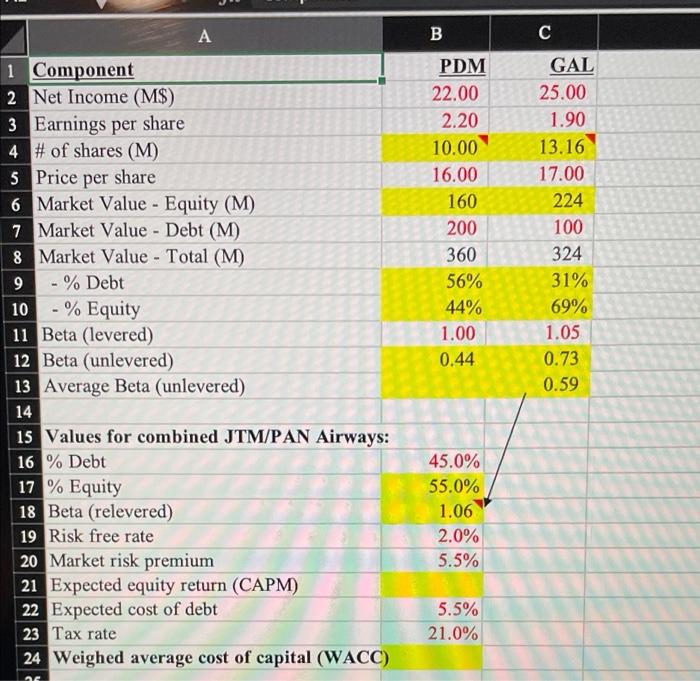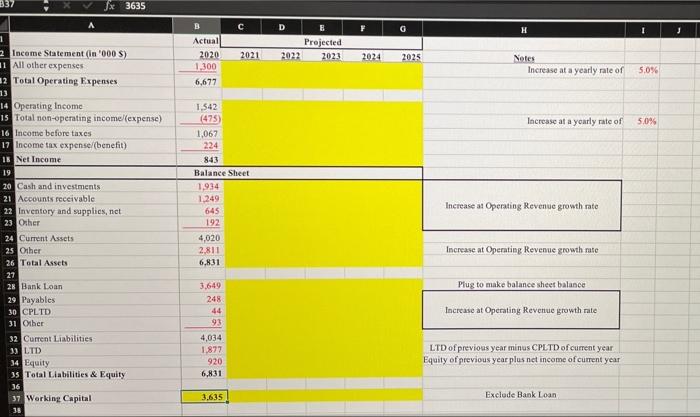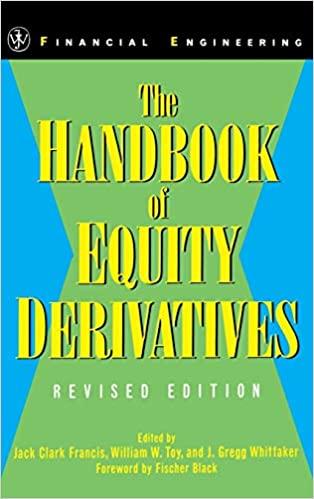Answered step by step
Verified Expert Solution
Question
1 Approved Answer
JTM Airlines, a privately held firm, is looking to buy additional gates at its home airport for $1,200,000. It has money in the bank, but





 JTM Airlines, a privately held firm, is looking to buy additional gates at its home airport for $1,200,000. It has money in the bank, but that money may not be spent as it is used to pay salaries, suppliers, and equipment. It asked its bank for a loan, but the bank refused unless the project had a return higher than JTM's weighed average cost of capital. Separately, PAN Airways' CEO approached JTM's CEO to sell the airline. As a result of all this, JTM has contracted you to: 1. Calculate JTM's weighed average cost of capital (WACC) based on two airlines trading in the capital markets - PDM and GAL. Since JTM does not trade, it has no beta, so you need to use these two firms as proxies. JTM's CFO kindly gave you the necessary information on PDM and GAL for you to do this with some assumptions for the combined entity too. 2. Aside from the purchase price, the gates will require a working capital infusion of $1,200,000 at purchase. JTM estimates the gates will generate cash flows of $305,000 inyear 1, inflating at 3%/year over the next 12 years. After that, the gates will revert to the airport operator and 75% of the working capital is recovered. Calculate the NPV and IRR of the gates. 3. You were given PAN's 2020 income statement (IS) and balance sheet (BS), along with forecasts of the revenue growth. Forecast the IS and BS for the next 5 years. 4. The price discussed by the two CEOs is $28M. You must value PAN Airways using free cash flows to see if this price is fair or not. 5. Last, you will consolidate the calculated balance sheet for PAN and the actual balance sheet for JTM and calculate the three ratios shown in the JTM balance sheet A B C 1 Component 2 Net Income (M$) 3 Earnings per share 4 # of shares (M) 5 Price per share 6 Market Value - Equity (M) 7 Market Value - Debt (M) 8 Market Value - Total (M) 9 - % Debt 10 - % Equity 11 Beta (levered) 12 Beta (unlevered) 13 Average Beta (unlevered) 14 15 Values for combined JTM/PAN Airways: 16 % Debt 17 % Equity 18 Beta (relevered) 19 Risk free rate 20 Market risk premium 21 Expected equity return (CAPM) 22 Expected cost of debt 23 Tax rate 24 Weighed average cost of capital (WACC) PDM 22.00 2.20 10.00 16.00 160 200 360 56% 44% 1.00 0.44 GAL 25.00 1.90 13.16 17.00 224 100 324 31% 69% 1.05 0.73 0.59 45.0% 55.0% 1.06 2.0% 5.5% 5.5% 21.0% F19 O E G D Year 2 F Year 4 Year 6 1 J Year 7 Years K L M Year 9 Year 10 Year 11 N Year 12 Start Year 1 Year 3 Years Investment Working Capital 4 Operating Cash Flow 5 Total Cash Flow 6 7 NPV & IRR 9 10 337 Sx 3635 B D F 0 H 1 J E Projected 2023 2021 2022 Actual 2020 1,300 6,677 2024 2025 Notes Increase at a yearly rate of 5.0% Increase at a yearly rate of 5.0% 1 2 Income Statement (in '000 S) 11 All other expenses 32 Total Operating Expenses 13 14 Operating Income 15 Total non-operating income expense) 16 Income before taxes 17 Income tax expense/(benefit) 13 Net Income 19 20 Cash and investments 21 Accounts receivable 22 Inventory and supplies, net 23 Other 24 Current Assets 25 Other 26 Total Assets 27 26 Bank Loan 29 Payables 30 CPLTD 31 Other 32 Current Liabilities 33 LTD 34 Equity 35 Total Liabilities & Equity 36 37 Working Capital 1.542 (475) 1,067 224 843 Balance Sheet 1,934 1.249 645 192 4,020 2,811 6,831 Increase at Operating Revenue growth rate Increase at Operating Revenue growth rate Plug to make balance sheet balance Increase at Operating Revenue growth rate 3.649 248 44 93 4,034 1.877 920 6,831 LTD of previous year minus CPLTD of current year Equity of previous year plus net income of current year 3.635 Exclude Bank Loan . E E F G H 2024 2025 TV B D 1 PAN Airways Cash Flow Valuation 2 3 (in '000 ) 2021 2022 2023 4 Income before taxes 5 + Interest 6 - Income before interest and taxes (EBIT) 7 8 EBIAT 9 Change in Working Capital 10 - Change in Other assets 11 Free Cash Flow (FCF) 12 PV of FCF 13 - Existing Debt 14 =Value of equity 15 16 17 18 19 20 21 22 22 D12 . fx 4417 B A E Actual 2020 240 7,013 5,588 192 13,033 3,325 16,358 D Projected 2021 2022 250 250 8,385 9,998 6,630 7,905 195 232 15,460 18,385 3,830 4,393 19,290 22,778 2023 Notes 250 12,040 9,520 280 22,090 5,105 27,195 1 2 Balance Sheet 3 Cash 4 Notes and Acc. Rec. 5 Inventory 6 Prepaid 7 Current Assets 8 Other 9 Total Assets 10 11 Bank Loan 12 Payables 13 CPLTD 14 Other 15 Current Liabilities 16 LTD 17 Equity 18 Total Liabilities & Equity 19 20 Ratios: 21 Bank Loan to Receivables 22 Liabilities / Equity 23 Debt / Equity 24 600 3,057 433 1,477 5,567 2,458 8,333 16,358 656 3,705 450 1,712 6,523 2,008 10,759 19,290 657 4,417 450 1,994 7,518 1,558 13,702 22,778 680 5,320 450 2,350 8,800 1,108 17,287 27,195 0.1 1.0 0.4 0.1 0.8 0.3 0.1 0.7 0.2 0.1 0.6 0.1 25
JTM Airlines, a privately held firm, is looking to buy additional gates at its home airport for $1,200,000. It has money in the bank, but that money may not be spent as it is used to pay salaries, suppliers, and equipment. It asked its bank for a loan, but the bank refused unless the project had a return higher than JTM's weighed average cost of capital. Separately, PAN Airways' CEO approached JTM's CEO to sell the airline. As a result of all this, JTM has contracted you to: 1. Calculate JTM's weighed average cost of capital (WACC) based on two airlines trading in the capital markets - PDM and GAL. Since JTM does not trade, it has no beta, so you need to use these two firms as proxies. JTM's CFO kindly gave you the necessary information on PDM and GAL for you to do this with some assumptions for the combined entity too. 2. Aside from the purchase price, the gates will require a working capital infusion of $1,200,000 at purchase. JTM estimates the gates will generate cash flows of $305,000 inyear 1, inflating at 3%/year over the next 12 years. After that, the gates will revert to the airport operator and 75% of the working capital is recovered. Calculate the NPV and IRR of the gates. 3. You were given PAN's 2020 income statement (IS) and balance sheet (BS), along with forecasts of the revenue growth. Forecast the IS and BS for the next 5 years. 4. The price discussed by the two CEOs is $28M. You must value PAN Airways using free cash flows to see if this price is fair or not. 5. Last, you will consolidate the calculated balance sheet for PAN and the actual balance sheet for JTM and calculate the three ratios shown in the JTM balance sheet A B C 1 Component 2 Net Income (M$) 3 Earnings per share 4 # of shares (M) 5 Price per share 6 Market Value - Equity (M) 7 Market Value - Debt (M) 8 Market Value - Total (M) 9 - % Debt 10 - % Equity 11 Beta (levered) 12 Beta (unlevered) 13 Average Beta (unlevered) 14 15 Values for combined JTM/PAN Airways: 16 % Debt 17 % Equity 18 Beta (relevered) 19 Risk free rate 20 Market risk premium 21 Expected equity return (CAPM) 22 Expected cost of debt 23 Tax rate 24 Weighed average cost of capital (WACC) PDM 22.00 2.20 10.00 16.00 160 200 360 56% 44% 1.00 0.44 GAL 25.00 1.90 13.16 17.00 224 100 324 31% 69% 1.05 0.73 0.59 45.0% 55.0% 1.06 2.0% 5.5% 5.5% 21.0% F19 O E G D Year 2 F Year 4 Year 6 1 J Year 7 Years K L M Year 9 Year 10 Year 11 N Year 12 Start Year 1 Year 3 Years Investment Working Capital 4 Operating Cash Flow 5 Total Cash Flow 6 7 NPV & IRR 9 10 337 Sx 3635 B D F 0 H 1 J E Projected 2023 2021 2022 Actual 2020 1,300 6,677 2024 2025 Notes Increase at a yearly rate of 5.0% Increase at a yearly rate of 5.0% 1 2 Income Statement (in '000 S) 11 All other expenses 32 Total Operating Expenses 13 14 Operating Income 15 Total non-operating income expense) 16 Income before taxes 17 Income tax expense/(benefit) 13 Net Income 19 20 Cash and investments 21 Accounts receivable 22 Inventory and supplies, net 23 Other 24 Current Assets 25 Other 26 Total Assets 27 26 Bank Loan 29 Payables 30 CPLTD 31 Other 32 Current Liabilities 33 LTD 34 Equity 35 Total Liabilities & Equity 36 37 Working Capital 1.542 (475) 1,067 224 843 Balance Sheet 1,934 1.249 645 192 4,020 2,811 6,831 Increase at Operating Revenue growth rate Increase at Operating Revenue growth rate Plug to make balance sheet balance Increase at Operating Revenue growth rate 3.649 248 44 93 4,034 1.877 920 6,831 LTD of previous year minus CPLTD of current year Equity of previous year plus net income of current year 3.635 Exclude Bank Loan . E E F G H 2024 2025 TV B D 1 PAN Airways Cash Flow Valuation 2 3 (in '000 ) 2021 2022 2023 4 Income before taxes 5 + Interest 6 - Income before interest and taxes (EBIT) 7 8 EBIAT 9 Change in Working Capital 10 - Change in Other assets 11 Free Cash Flow (FCF) 12 PV of FCF 13 - Existing Debt 14 =Value of equity 15 16 17 18 19 20 21 22 22 D12 . fx 4417 B A E Actual 2020 240 7,013 5,588 192 13,033 3,325 16,358 D Projected 2021 2022 250 250 8,385 9,998 6,630 7,905 195 232 15,460 18,385 3,830 4,393 19,290 22,778 2023 Notes 250 12,040 9,520 280 22,090 5,105 27,195 1 2 Balance Sheet 3 Cash 4 Notes and Acc. Rec. 5 Inventory 6 Prepaid 7 Current Assets 8 Other 9 Total Assets 10 11 Bank Loan 12 Payables 13 CPLTD 14 Other 15 Current Liabilities 16 LTD 17 Equity 18 Total Liabilities & Equity 19 20 Ratios: 21 Bank Loan to Receivables 22 Liabilities / Equity 23 Debt / Equity 24 600 3,057 433 1,477 5,567 2,458 8,333 16,358 656 3,705 450 1,712 6,523 2,008 10,759 19,290 657 4,417 450 1,994 7,518 1,558 13,702 22,778 680 5,320 450 2,350 8,800 1,108 17,287 27,195 0.1 1.0 0.4 0.1 0.8 0.3 0.1 0.7 0.2 0.1 0.6 0.1 25






Step by Step Solution
There are 3 Steps involved in it
Step: 1

Get Instant Access to Expert-Tailored Solutions
See step-by-step solutions with expert insights and AI powered tools for academic success
Step: 2

Step: 3

Ace Your Homework with AI
Get the answers you need in no time with our AI-driven, step-by-step assistance
Get Started


